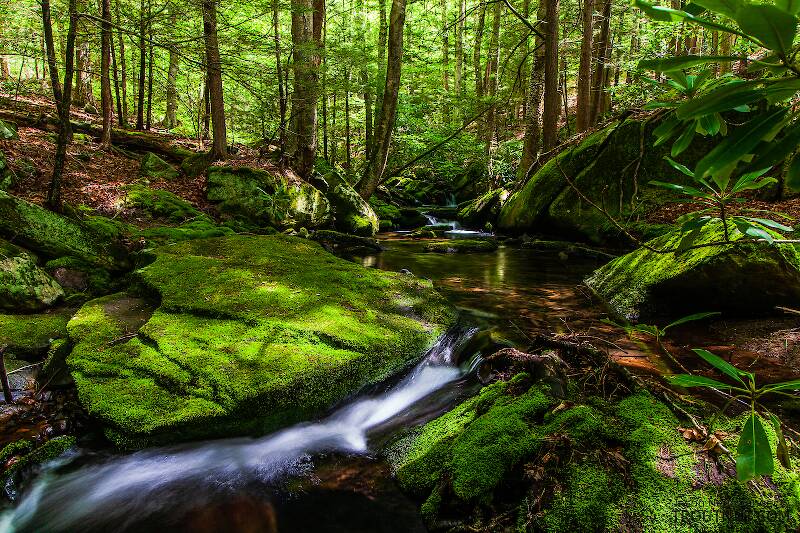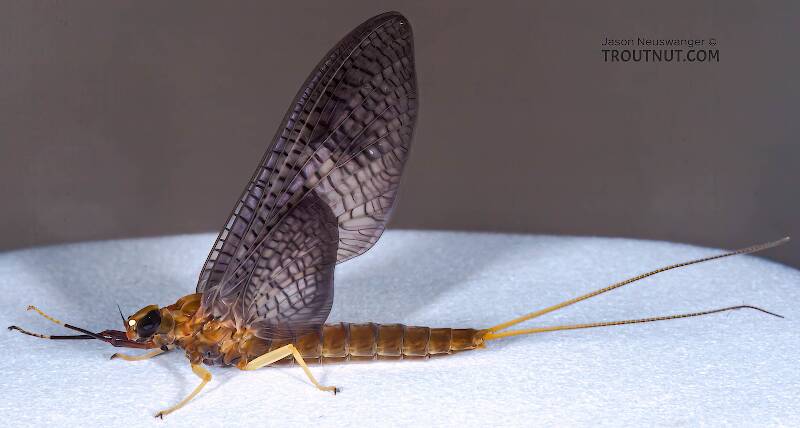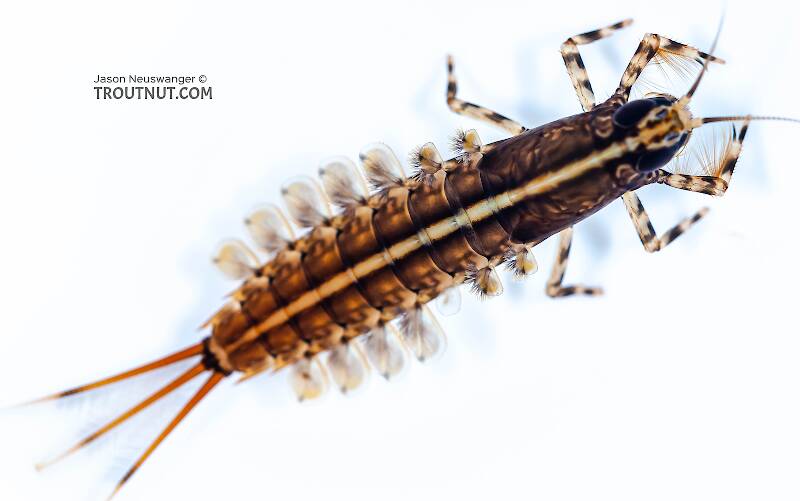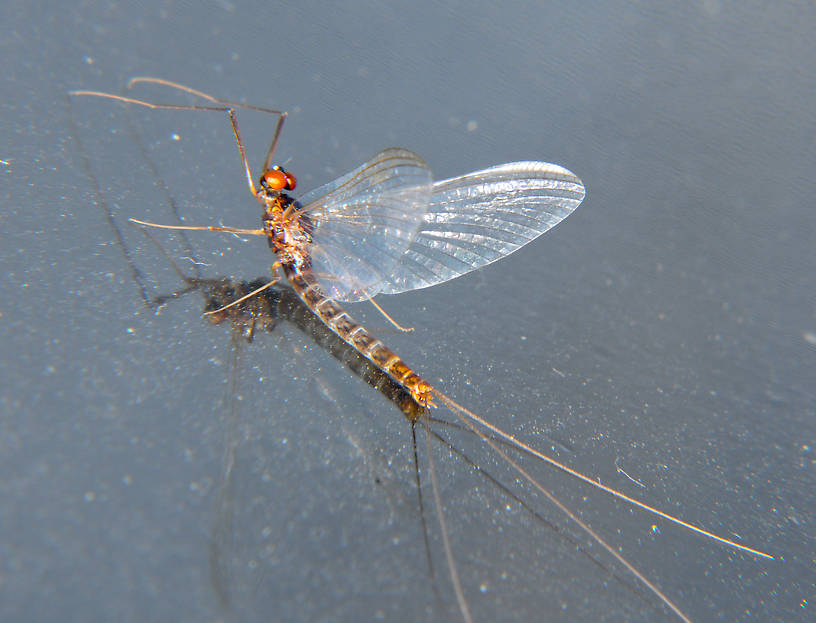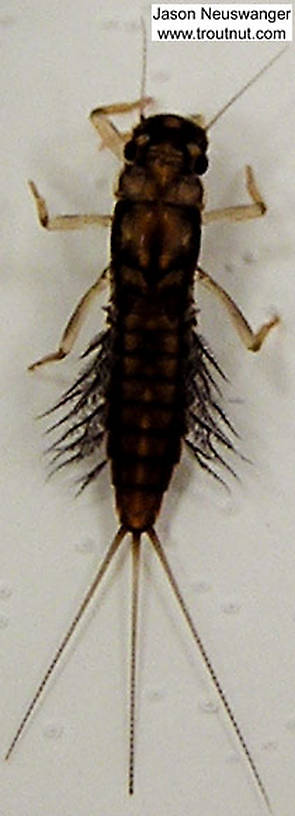
Blue-winged Olives
Baetis
Tiny Baetis mayflies are perhaps the most commonly encountered and imitated by anglers on all American trout streams due to their great abundance, widespread distribution, and trout-friendly emergence habits.
Featured on the forum

This is the first of it's family I've seen, collected from a tiny, fishless stream in the Cascades. The three species of this genus all live in the Northwest and are predators that primarily eat stonefly nymphs Merritt R.W., Cummins, K.W., and Berg, M.B. (2019).

Troutnut is a project started in 2003 by salmonid ecologist Jason "Troutnut" Neuswanger to help anglers and
fly tyers unabashedly embrace the entomological side of the sport. Learn more about Troutnut or
support the project for an enhanced experience here.
Mahogany Duns
Like most common names,"Mahogany Dun" can refer to more than one taxon. They're previewed below, along with 9 specimens. For more detail click through to the scientific names.
Mayfly Species Isonychia bicolor
These are pretty much always called Mahogany Duns.
This is by far the most important species of Isonychia. Many angling books once split its credit with the species Isonychia sadleri and Isonychia harperi, but entomologists have since discovered that those are just variations of this abundant species.
See the main Isonychia page for more about these intriguing mayflies.
See the main Isonychia page for more about these intriguing mayflies.
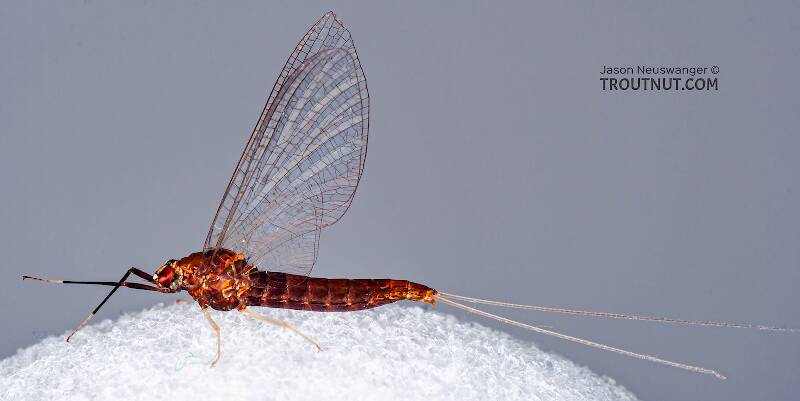
I collected this female together with a male.
See 16 more specimens...
Mayfly Species Paraleptophlebia bicornuta
These are pretty much always called Mahogany Duns.
This important Western species is one of the few mayflies outside the Ephemeridae family to possess large tusks on the front of its head. It is also one of the largest species of Paraleptophlebia.
P. bicornuta is often reinforced by simultaneous hatches of the more common Paraleptophlebia debilis. The two duns appear virtually identical to the naked eye, though bicornuta usually has an edge in size.
Paraleptophlebia bicornuta is by far the widest distributed tusked species, though there are others. Telling the tusked species apart is very difficult and even entomological texts are largely ambiguous on the characters that differentiate them. Distribution records are probably the most reliable way for anglers to know with any probability what they are looking at. Check out the Paraleptophlebia packii and Paraleptophlebia helena hatch pages for more distribution information.
P. bicornuta is often reinforced by simultaneous hatches of the more common Paraleptophlebia debilis. The two duns appear virtually identical to the naked eye, though bicornuta usually has an edge in size.
Paraleptophlebia bicornuta is by far the widest distributed tusked species, though there are others. Telling the tusked species apart is very difficult and even entomological texts are largely ambiguous on the characters that differentiate them. Distribution records are probably the most reliable way for anglers to know with any probability what they are looking at. Check out the Paraleptophlebia packii and Paraleptophlebia helena hatch pages for more distribution information.
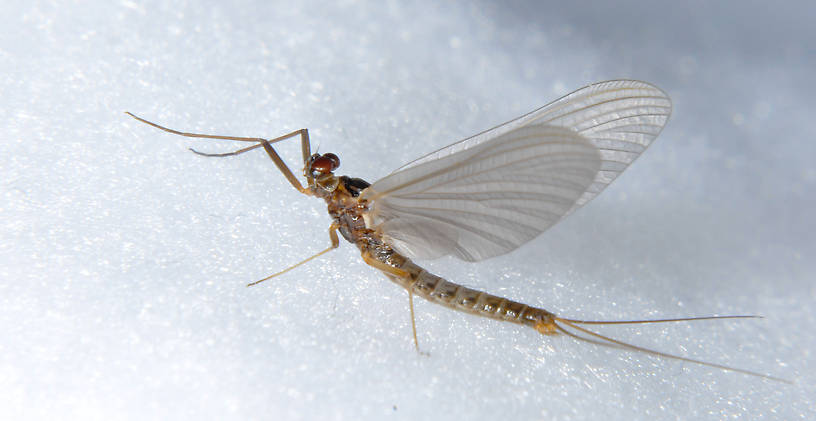
You wonder sometimes how certain insects get their common names. This one is called the 'mahogany dun' for some unknown reason.
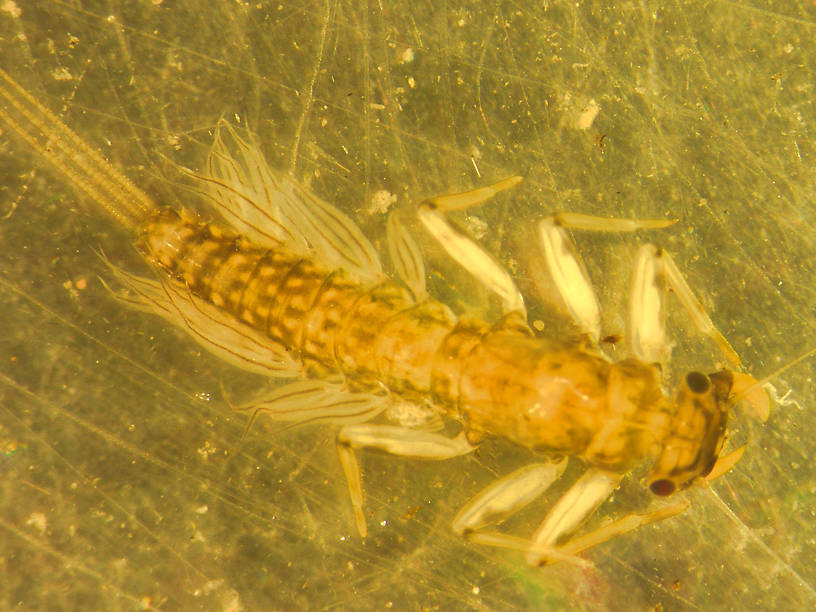
This species is interesting because it is common in lakes as well as streams. It is one of the last species of the year to emerge in western Montana. Adults have been collected as late as October 15 weather permitting.
See 2 more specimens...
Mayfly Species Paraleptophlebia debilis
These are pretty much always called Mahogany Duns.
This widespread species can produce memorable hatches where it is locally abundant, especially in the West where it also tends to run larger in size. It loves the margins as is typical of most Leptophlebiidae species but has a greater tolerance for current. They are often found even in riffles. This is the most important species in the West.
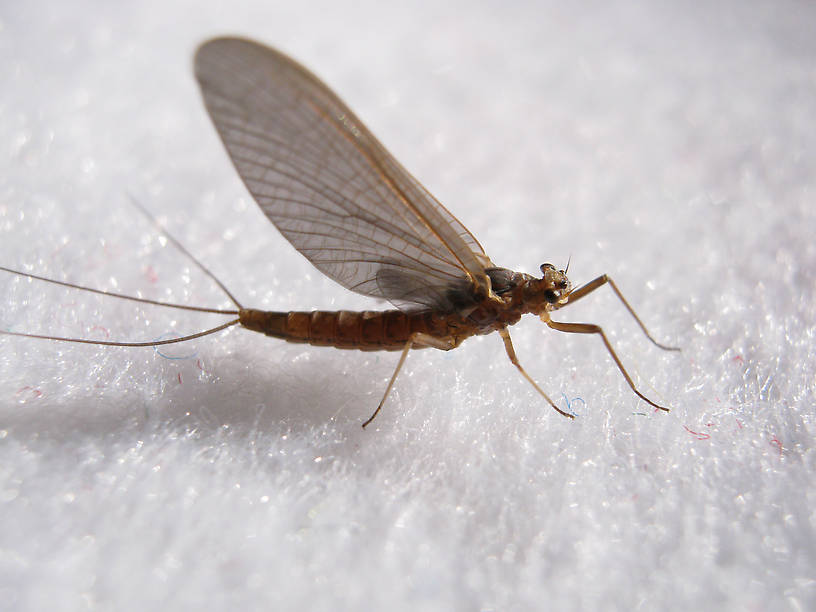
Size: 9mm. These photos really highlight the brown pigmentation of the wing venation, but in the hand the wings look to be a uniform smokey gray. - Entoman
Mayfly Species Paraleptophlebia helena
These are pretty much always called Mahogany Duns.
This large species of Paraleptophlebia is one of the tusked group. Records indicate it is endemic to California where it fills the niche taken by Paraleptophlebia bicornuta in neighboring states. It usually hatches with the more common and very similar looking duns of Paraleptophlebia debilis.
Mayfly Species Paraleptophlebia packii
These are pretty much always called Mahogany Duns.
This large western species is common in places. It is one of the few that has tusks and substitutes for the more common tusked Paraleptophlebia bicornuta in some locales, particularly the central Rockies in parts of Colorado, Utah, and Wyoming where they have been documented. Telling the tusked species apart is very difficult and even entomological texts are largely ambiguous on the characters that differentiate the nymphs. Angling texts relying on gill morphology, terga pattern, and tusk shape are dubious at best. For now, the angler's best bet is to rely somewhat on documented distribution.
Mayfly Species Paraleptophlebia praepedita
These are pretty much always called Mahogany Duns.
This species may reinforce hatches of Paraleptophlebia debilis.
Mayfly Genus Paraleptophlebia
These are often called Mahogany Duns.
There are many species in this genus of mayflies, and some of them produce excellent hatches. Commonly known as Blue Quills or Mahogany Duns, they include some of the first mayflies to hatch in the Spring and some of the last to finish in the Fall.
In the East and Midwest, their small size (16 to 20, but mostly 18's) makes them difficult to match with old techniques. In the 1950s Ernest Schwiebert wrote in Matching the Hatch:
Fortunately, modern anglers with experience fishing hatches of tiny Baetis and Tricorythodes mayflies (and access to space-age tippet materials) are better prepared for eastern Paraleptophlebia. It's hard to make sense of so many species, but only one is very important and others can be considered in groups because they often hatch together:
In the East and Midwest, their small size (16 to 20, but mostly 18's) makes them difficult to match with old techniques. In the 1950s Ernest Schwiebert wrote in Matching the Hatch:
"The Paraleptophlebia hatches are the seasonal Waterloo of most anglers, for without fine tippets and tiny flies an empty basket is assured."
Fortunately, modern anglers with experience fishing hatches of tiny Baetis and Tricorythodes mayflies (and access to space-age tippet materials) are better prepared for eastern Paraleptophlebia. It's hard to make sense of so many species, but only one is very important and others can be considered in groups because they often hatch together:
- Paraleptophlebia adoptiva is by far the most important species of this genus in the two regions and is an early Spring emerger.
- Paraleptophlebia mollis, Paraleptophlebia guttata, and Paraleptophlebia strigula complement each other in late spring and early summer.
- Paraleptophlebia debilis and Paraleptophlebia praepedita occur together in the fall.
- The most important species is Paraleptophlebia debilis. This large (for the genus) Fall emerger can be found throughout the region. It is often accompanied by one of the slightly larger tusked species. Depending on locale, this can be Paraleptophlebia bicornuta (the most common), Paraleptophlebia packii or Paraleptophlebia helena. Check out their hatch pages for distribution information.
- Spring is the season for the smaller Paraleptophlebia heteronea throughout most of the region with Paraleptophlebia gregalis filling this niche in California and parts of Oregon.

Size: 9mm. These photos really highlight the brown pigmentation of the wing venation, but in the hand the wings look to be a uniform smokey gray. - Entoman

This specimen (and a few others I collected but didn't photograph) appear to represent the first finding of Paraleptophlebia sculleni outside the Oregon Cascades, although it is not a monumental leap from there to the Washington Cascades. The key characteristics are fairly clear.
See 18 more specimens...
References
- Merritt R.W., Cummins, K.W., and Berg, M.B. 2019. An Introduction to the Aquatic Insects of North America (Fifth Edition). Kendall/Hunt Publishing Company.
- Schwiebert, Ernest G. 1955. Matching the Hatch. MacMillan Publishing Company.

